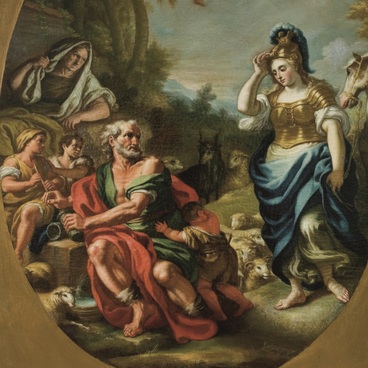‘The Miracle of DemEtrius of ThessalOniki’ is one of the oldest works in the collection of NovosibIrsk State Art Museum. It was created in the 16th century in line with the traditions of Moscow icon painting school. The works of its masters were distinguished by the softness of strokes and harmonious color, which we can see in the image of Demetrius of Thessaloniki.
The story of Demetrius of Thessaloniki took place in the 3rd century A.D., when Roman pagans persecuted Christians. Demetrius was born in Thessaloniki into a family that had secretly accepted the Christian teaching. The young man then joined the service of Emperor GalErius, becoming the proconsul of the Thessalonica district. Demetrius’s main duty was to protect the city from barbarians and exterminate Christians. However, having returned to his hometown, he began to praise Jesus Christ and took the path of open asceticism. He managed to convert many Thessalonians to Christianity. Galerius was enraged. He ordered to imprison the young man and soon executed him.
Later Great-Martyr Demetrius of Thessaloniki was venerated in the medieval state of Rus' as the heavenly patron of the Slavic peoples. It is for this reason that Russian princes so often named their firstborns after this Saint.
Traditionally, Demetrius is portrayed in military uniform, since according to his hagiography, he was a warrior and a ruler of Thessaloniki. But during the times of the fight against the Tatar-Mongol invasion, the image of St. Demetrius acquired new features. Artists of Rus' started to depict him fighting against Bulgarian pagan tsar KaloyAn who besieged the Christian city of Thessaloniki. It was this plot that has inspired the icon from the museum’s collection.
According to ‘The Miracles of Saint Demetrius’, tsar Kaloyan had ravaged many cities in Macedonia and Thrace and was going to conquer Thessaloniki. When Kaloyan approached the city and stopped to rest, Demetrius appeared on a white horse and pierced his heart with a lance. Kaloyan woke up with a deep wound and managed to tell the commanders about his vision. After his death the army retreated in fear.
The story of Demetrius of Thessaloniki took place in the 3rd century A.D., when Roman pagans persecuted Christians. Demetrius was born in Thessaloniki into a family that had secretly accepted the Christian teaching. The young man then joined the service of Emperor GalErius, becoming the proconsul of the Thessalonica district. Demetrius’s main duty was to protect the city from barbarians and exterminate Christians. However, having returned to his hometown, he began to praise Jesus Christ and took the path of open asceticism. He managed to convert many Thessalonians to Christianity. Galerius was enraged. He ordered to imprison the young man and soon executed him.
Later Great-Martyr Demetrius of Thessaloniki was venerated in the medieval state of Rus' as the heavenly patron of the Slavic peoples. It is for this reason that Russian princes so often named their firstborns after this Saint.
Traditionally, Demetrius is portrayed in military uniform, since according to his hagiography, he was a warrior and a ruler of Thessaloniki. But during the times of the fight against the Tatar-Mongol invasion, the image of St. Demetrius acquired new features. Artists of Rus' started to depict him fighting against Bulgarian pagan tsar KaloyAn who besieged the Christian city of Thessaloniki. It was this plot that has inspired the icon from the museum’s collection.
According to ‘The Miracles of Saint Demetrius’, tsar Kaloyan had ravaged many cities in Macedonia and Thrace and was going to conquer Thessaloniki. When Kaloyan approached the city and stopped to rest, Demetrius appeared on a white horse and pierced his heart with a lance. Kaloyan woke up with a deep wound and managed to tell the commanders about his vision. After his death the army retreated in fear.

